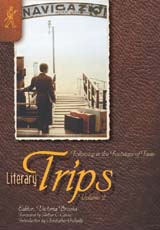Amsterdam Through Rembrandt's Eyes
Elm and chestnut trees dressed in the yellow gold of autumn are reflected in the broad canals. Sunlight glints off gilded towers. Nature is cooperating with my search for the Golden Age of Amsterdam as portrayed by its most famous artist, Rembrandt van Rijn (1606-1669). I have come to pay him homage and to see with my own eyes the images that inspired him to take out his sketch pad as he strolled this city of islands linked by narrow bridges. He died on an October day much like the one I chose to trail his ghost through the corridors of time.
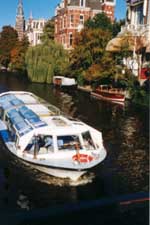 "Have you been to Amsterdam before?" The taxi driver who drove me from Schiphol Airport to my hotel in the historic heart of the city slipped into perfect conversational English.
"Have you been to Amsterdam before?" The taxi driver who drove me from Schiphol Airport to my hotel in the historic heart of the city slipped into perfect conversational English.
I told him I had once lived in The Hague and made regular visits to Amsterdam.
"Did you learn to speak Dutch?"
"No," I said with little thought. "I was studying French at the time and didn't want to confuse a smattering of one foreign language with scraps of another. Besides, everyone in Holland speaks English."
"Well, you should have learned Dutch." He probably didn't mean to sound like he was scolding me, but that is the way his words came across and I was puzzled. Had I arrived during an upsurge of Dutch nationalism? Later I learned that Amsterdam today is much like it was during the Golden Age when people swarmed in from everywhere in search of religious and political freedom or economic opportunity. I have been involved in heated debates over bilingual education in my own country and can understand why the Dutch might be concerned about the preservation of their language, as their country becomes more ethnically diverse.
Amsterdam was a global village centuries before the term was invented. Its merchants were the wealthiest men of their day. It was the perfect place for a man of Rembrandt's liberal, eclectic genius, who was also in search of lucrative commissions.
During previous visits I have stood in awe before Rembrandt's masterpiece The Night Watch in the Rijksmuseum and found my way to his home on Jodenbreestraat in the days when it was ill prepared for the crush of tourists arriving at the door. On this trip, I wanted to see the house after its recent restoration and discover all the other places with connections to the artist.
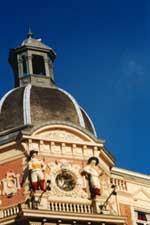 One of those sites is the Golden Tulip Doelen, a mansion on the Amstel River in the core of old Amsterdam. It was built in 1882 on a piece of land where the Rifleman's Guild came for meetings and target practice. The company commanded by Captain Frans Banning Cocq commissioned Rembrandt to paint a group portrait in 1642. The result was The Night Watch, a painting that shattered traditional modes of portraiture by subordinating the individual to the action of the group, and became one of the most famous paintings of all time. The original exterior wall of the 17th-century Doelen (target) Room was uncovered during recent renovation. In honor of Rembrandt, the wall has been preserved in its original form to show where his masterpiece hung for 75 years.
One of those sites is the Golden Tulip Doelen, a mansion on the Amstel River in the core of old Amsterdam. It was built in 1882 on a piece of land where the Rifleman's Guild came for meetings and target practice. The company commanded by Captain Frans Banning Cocq commissioned Rembrandt to paint a group portrait in 1642. The result was The Night Watch, a painting that shattered traditional modes of portraiture by subordinating the individual to the action of the group, and became one of the most famous paintings of all time. The original exterior wall of the 17th-century Doelen (target) Room was uncovered during recent renovation. In honor of Rembrandt, the wall has been preserved in its original form to show where his masterpiece hung for 75 years.
The Beatles were among the Doelen's celebrated guests who arrived by boat and slipped in the back door to avoid the mob waiting for them at the street entrance. The influence of frequent visitors Edward VII and his mistress Lilly Langtree can be felt in the Balmoral pub and restaurant and the Langtree salon.
With the Doelen Hotel as my headquarters, I began my quest. I did not have to go far. Rembrandt and his wife, Saskia, once lived next door to the hotel in what is now the lively and popular Café de Jaren where the buzz of music and conversation reverberates far into the night.
The walk that I will follow begins on Jodenbreestraat and ends at the Westerkerk, one of the city's monumental churches, where Rembrandt was buried in a pauper's grave on Oct. 4, 1669.
From the Café de Jaren I head straight for Number 4 Jodenbreestraat where Rembrandt lived from 1639 until 1658, during the height of his fame as an artist, teacher art dealer and serious collector of art and objets. It was the Old Jewish Quarter then, but little of that atmosphere remains. Rembrandt's home is one of the few Renaissance-style structures still standing on the Joden.
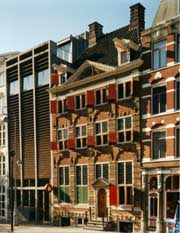 My favorite room in the Rembrandt House is the cozy reception chamber off the large entrance hall. It would appear that Rembrandt absorbed the mercantile spirit of his day and marketed his works with a sophistication most artists even now would envy. Prospective buyers were invited into the anteroom where they were served a glass of wine chilled in a marble cooler to be sipped at leisure as they examined the paintings and prints that were for sale. Another example of his marketing savvy is the inordinate number of self-portraits he painted. In the days before photography and mass media, the portraits were a way to keep his name and face before the public
My favorite room in the Rembrandt House is the cozy reception chamber off the large entrance hall. It would appear that Rembrandt absorbed the mercantile spirit of his day and marketed his works with a sophistication most artists even now would envy. Prospective buyers were invited into the anteroom where they were served a glass of wine chilled in a marble cooler to be sipped at leisure as they examined the paintings and prints that were for sale. Another example of his marketing savvy is the inordinate number of self-portraits he painted. In the days before photography and mass media, the portraits were a way to keep his name and face before the public
Cosseted in the anteroom, I try to picture myself in velvets and lace clutching a brocaded purse bulging with gold florins. I have come to commission my portrait. That self-image fades quickly when I am reminded that the U.S. stock market is bouncing from new highs to lows almost daily, just as the price of tulips did during the tulip mania of Rembrandt's day. My portrait would have to be paid for from speculative excesses that might not materialize. Perhaps it was just as well that I wouldn't be commissioning a portrait. As a favored client who has journeyed some distance, I might be invited to spend the night. I could never fold myself into the tiny built-in box bed. I am told by a guide that in Rembrandt's day people slept sitting up and that is why the beds are so short.
No matter how many commissions he received, Rembrandt lived beyond his means. A quick check of the Dow Jones Industrial Average on my PalmPilot and I can see myself in Rembrandt's velvet house slippers trudging after an appraiser who is scribbling an inventory of every painting, bibelot and stick of furniture for the ensuing auction to settle the painter's debts. It is estimated that when the inventory was taken in 1656, Rembrandt's treasures were valued at over 18,000 guilders, a remarkable sum of money in those days.
From Rembrandt's House I wend my way to Nieuwmarkt, a section of the old city dominated by a Disneyesque, centuries-old brick building with multiple turrets and roof elevations. Known as de Waag, it was once the eastern gate of Amsterdam and later a public weighing house and guildhall. During Rembrandt's day, the Guild of Surgeons met in the Waag. One of them, an illustrious professor of anatomy, commissioned the now widely recognized masterpiece The Anatomy Lesson of Doctor Nicolaes Tulp.
In an unexpected blend of nostalgically old and brashly new, I discover a restaurant-cybercafé among all the rooms and turrets. My fellow travelers join me in the flamboyant, light-filled Café In de Waag for a sandwich and drink. Before leaving we queue up to surf the Internet and soon find the latest news on where the parties are.
After the Nieuwmarkt, my next stop is the Royal Palace in the effervescent Dam Square where street life is always at pitch level. Built as the city hall, the massively large and festooned building was a symbol of the power and prestige of Amsterdam during the Golden Age. To Rembrandt it was a galling reminder that his life and fortunes were rapidly going downhill. His pupils received most of the commissions for decorating the new building. When The Night Watch was moved to the War Council chambers the movers cut off a sizeable strip from the left and bottom sides to get it through the door. Bankruptcy proceedings against Rembrandt were also handled at the city hall.
In 1660 Rembrandt was forced to move to a much smaller house on the Rozengracht. His dark-hued paintings were no longer in fashion, yet many of the works he created during this period became famous after his death. The house on Rozengracht was demolished during the 19th century, but a memorial stone to the painter has been installed at the site.
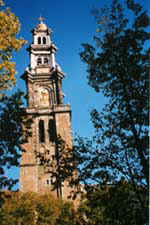 Rembrandt outlived his wife, Saskia, his mistress Hendrickje Stoffels, and all his children. He was buried in the Westerkerk on Prinsengracht, a church that is also famous because of its connection to Anne Frank, who mentions in her diary how she was soothed by the music of the Westerkerk's carillon when she and her family were in hiding in the building next door.
Rembrandt outlived his wife, Saskia, his mistress Hendrickje Stoffels, and all his children. He was buried in the Westerkerk on Prinsengracht, a church that is also famous because of its connection to Anne Frank, who mentions in her diary how she was soothed by the music of the Westerkerk's carillon when she and her family were in hiding in the building next door.
The perfect finale to my golden day in Amsterdam is dinner in the Rembrandt Room of the d' Vijff Vlieghen, known to travelers as the Five Flies restaurant. Cobbled together from five adjoining 17th-century houses, its unique atmosphere and world-famous cuisine has attracted film stars, musicians and celebrities from Elvis Presley to Goldie Hawn and Bruce Springsteen.
When You Go:
Amsterdam Tourist Office offers a heart-warming Winter Adventure Package through March 15, 2000. Choices vary from budget to first-class accommodations. Prices vary accordingly. Includes the Amsterdam Culture and Leisure Pass with vouchers, discounts and a free canal-boat trip. Call the Amsterdam Reservation Center at +31 777 000 888, Mon.-Sat. 9 a.m.-6 p.m.
For general information on what Holland has to offer any time of year, contact The Netherlands Board of Tourism, Tel: 1-888-464-6552, e-mail: go2holland.com, Website: www.goholland.com.
Guides, most of whom speak a variety of languages, are available for art tours or tours that emphasize other specific facets of Amsterdam including history, architecture and certain neighborhoods. High standards are enforced by Guidor, the association of guides: Reservations: 070-4195520, or call the Amsterdam Tourist Office, Tel: 31-900-4004040.
Golden Tulip Doelen Hotel, Nieuwe Doelenstraat 24, 1012 CP, Amsterdam. Reservations: Tel: 01131-20-554-0600 or e-mail sales@gtdoelen.goldentulip.nl.
Restaurant-Café In de Waag, Nieuwmarkt 4, 1012 CR Amsterdam.Tel: 020 422 77 72. E-mail: info@indewaag.nl. International cuisine, organic produce, friendly staff, and a reading table with computers have made Café in de Waag a favorite with locals.
Restaurant d'Vijff Vlieghen, the Five Flies, is internationally famous for its New Dutch Cuisine. It is open for dinner every day from 5:30 p.m. Open for lunch on request (minimum booking of 20). Located at Spuistraat 294-302, the entrance is at Vlieghendesteeg 1. Tel: +31 20 624-83 69, e-mail: restaurants@d-vijffvlieghen.com, Website: www.d-vijffvlieghen.com.
Rijksmuseum, Stadhouderskade 42. Tel: +31 (0) 20 674-70 00. E-mail: info@rijksmuseum.nl. The Rijksmuseum has the largest collection of Dutch art in the world.
Museum het Rembrandthuis, Rembrandt House Museum, Jodenbreestraat 4, Amsterdam. Tel: +31 (0) 20 - 520-04 00. Open Mon-Sat., 10 a.m.-5 p.m., Sundays and holidays 1-5 p.m.
Cosseted in the anteroom, I try to picture myself in velvets and lace clutching a brocaded purse bulging with gold florins. I have come to commission my portrait. That self-image fades quickly when I am reminded that the U.S. stock market is bouncing from new highs to lows almost daily, just as the price of tulips did during the tulip mania of Rembrandt's day. My portrait would have to be paid for from speculative excesses that might not materialize. Perhaps it was just as well that I wouldn't be commissioning a portrait. As a favored client who has journeyed some distance, I might be invited to spend the night. I could never fold myself into the tiny built-in box bed. I am told by a guide that in Rembrandt's day people slept sitting up and that is why the beds are so short.No matter how many commissions he received, Rembrandt lived beyond his means. A quick check of the Dow Jones Industrial Average on my PalmPilot and I can see myself in Rembrandt's velvet house slippers trudging after an appraiser who is scribbling an inventory of every painting, bibelot and stick of furniture for the ensuing auction to settle the painter's debts. It is estimated that when the inventory was taken in 1656, Rembrandt's treasures were valued at over 18,000 guilders, a remarkable sum of money in those days.
From Rembrandt's House I wend my way to Nieuwmarkt, a section of the old city dominated by a Disneyesque, centuries-old brick building with multiple turrets and roof elevations. Known as de Waag, it was once the eastern gate of Amsterdam and later a public weighing house and guildhall. During Rembrandt's day, the Guild of Surgeons met in the Waag. One of them, an illustrious professor of anatomy, commissioned the now widely recognized masterpiece The Anatomy Lesson of Doctor Nicolaes Tulp.
In an unexpected blend of nostalgically old and brashly new, I discover a restaurant-cybercafé among all the rooms and turrets. My fellow travelers join me in the flamboyant, light-filled Café In de Waag for a sandwich and drink. Before leaving we queue up to surf the Internet and soon find the latest news on where the parties are.
After the Nieuwmarkt, my next stop is the Royal Palace in the effervescent Dam Square where street life is always at pitch level. Built as the city hall, the massively large and festooned building was a symbol of the power and prestige of Amsterdam during the Golden Age. To Rembrandt it was a galling reminder that his life and fortunes were rapidly going downhill. His pupils received most of the commissions for decorating the new building. When The Night Watch was moved to the War Council chambers the movers cut off a sizeable strip from the left and bottom sides to get it through the door. Bankruptcy proceedings against Rembrandt were also handled at the city hall.
In 1660 Rembrandt was forced to move to a much smaller house on the Rozengracht. His dark-hued paintings were no longer in fashion, yet many of the works he created during this period became famous after his death. The house on Rozengracht was demolished during the 19th century, but a memorial stone to the painter has been installed at the site.
 Rembrandt outlived his wife, Saskia, his mistress
Hendrickje Stoffels, and all his children. He was buried in the Westerkerk on
Prinsengracht, a church that is also famous because of its connection to Anne Frank, who
mentions in her diary how she was soothed by the music of the Westerkerk's carillon when
she and her family were in hiding in the building next door.
Rembrandt outlived his wife, Saskia, his mistress
Hendrickje Stoffels, and all his children. He was buried in the Westerkerk on
Prinsengracht, a church that is also famous because of its connection to Anne Frank, who
mentions in her diary how she was soothed by the music of the Westerkerk's carillon when
she and her family were in hiding in the building next door.
The perfect finale to my golden day in Amsterdam is dinner in the Rembrandt Room of the d' Vijff Vlieghen, known to travelers as the Five Flies restaurant. Cobbled together from five adjoining 17th-century houses, its unique atmosphere and world-famous cuisine has attracted film stars, musicians and celebrities from Elvis Presley to Goldie Hawn and Bruce Springsteen.
When You Go:
Amsterdam Tourist Office offers a heart-warming Winter Adventure Package through March 15, 2000. Choices vary from budget to first-class accommodations. Prices vary accordingly. Includes the Amsterdam Culture and Leisure Pass with vouchers, discounts and a free canal-boat trip. Call the Amsterdam Reservation Center at +31 777 000 888, Mon.-Sat. 9 a.m.-6 p.m.
For general information on what Holland has to offer any time of year, contact The Netherlands Board of Tourism, Tel: 1-888-464-6552, e-mail: go2holland.com, Website: www.goholland.com.
Guides, most of whom speak a variety of languages, are available for art tours or tours that emphasize other specific facets of Amsterdam including history, architecture and certain neighborhoods. High standards are enforced by Guidor, the association of guides: Reservations: 070-4195520, or call the Amsterdam Tourist Office, Tel: 31-900-4004040.
Golden Tulip Doelen Hotel, Nieuwe Doelenstraat 24, 1012 CP, Amsterdam. Reservations: Tel: 01131-20-554-0600 or e-mail sales@gtdoelen.goldentulip.nl.
Restaurant-Café In de Waag, Nieuwmarkt 4, 1012 CR Amsterdam.Tel: 020 422 77 72. E-mail: info@indewaag.nl. International cuisine, organic produce, friendly staff, and a reading table with computers have made Café in de Waag a favorite with locals.
Restaurant d'Vijff Vlieghen, the Five Flies, is internationally famous for its New Dutch Cuisine. It is open for dinner every day from 5:30 p.m. Open for lunch on request (minimum booking of 20). Located at Spuistraat 294-302, the entrance is at Vlieghendesteeg 1. Tel: +31 20 624-83 69, e-mail: restaurants@d-vijffvlieghen.com, Website: www.d-vijffvlieghen.com.
Rijksmuseum, Stadhouderskade 42. Tel: +31 (0) 20 674-70 00. E-mail: info@rijksmuseum.nl. The Rijksmuseum has the largest collection of Dutch art in the world.
Museum het Rembrandthuis, Rembrandt House Museum, Jodenbreestraat 4, Amsterdam. Tel: +31 (0) 20 - 520-04 00. Open Mon-Sat., 10 a.m.-5 p.m., Sundays and holidays 1-5 p.m.

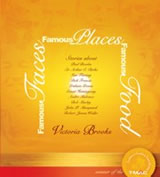 Famous Faces, Famous Places and Famous Foods
Famous Faces, Famous Places and Famous Foods
